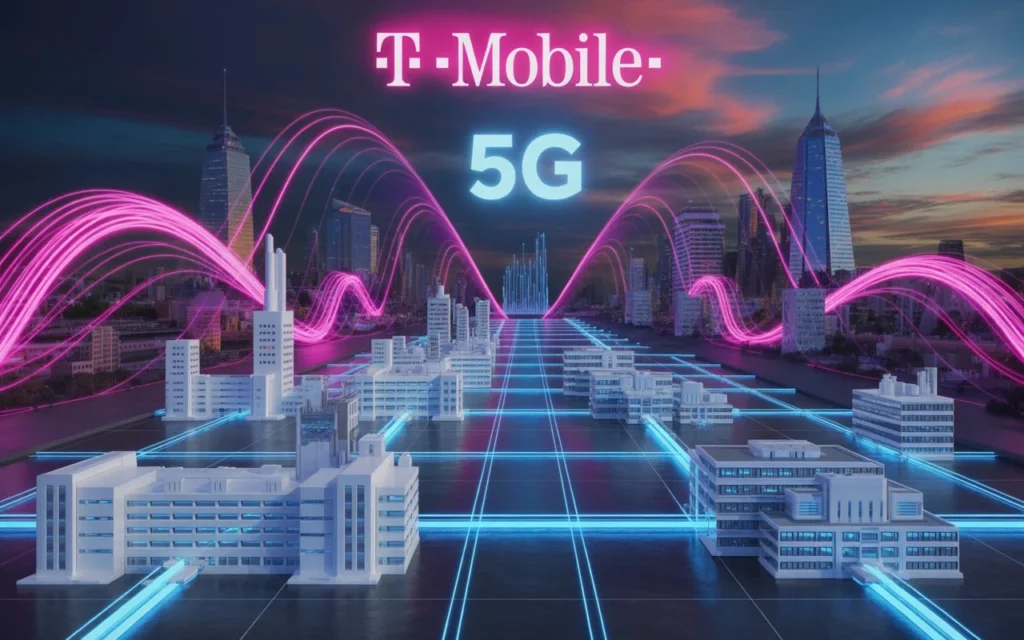Table of Contents
T-Mobile has taken a bold step forward in enterprise wireless connectivity with the launch of its 5G-Advanced public-private breakout feature — designed to bring private-network-like performance over a public 5G network. By blending the best of public and private wireless networks, T-Mobile aims to serve enterprises in healthcare, manufacturing, logistics and beyond.
In this blog we will explore what this means, how it works, and why it matters — and why companies should pay attention.

What is 5G-Advanced & the Public-Private Breakout Feature? – T-Mobile 5G-Advanced Public-Private Breakout
For background, “5G-Advanced” refers to the next evolution of 5G technology (beyond standard 5G) offering improved latency, throughput, reliability and new enterprise-capabilities. In T-Mobile’s case, the “public-private breakout” feature enables a hybrid mode: a managed public network that offers the benefits of a private network for enterprises.
T-Mobile’s offering includes:
- Edge Control local breakout — lets enterprises route traffic optimally (for example sensitive traffic stays on private paths) while non-sensitive traffic uses the public network.
- T-Platform orchestration layer — a unified portal giving customers visibility and control through a single platform.
- Leveraging T-Mobile’s existing 5G-Advanced / 5G Standalone (SA) infrastructure.
In short: enterprises can achieve near-private-network performance and control without the cost and complexity of building a fully isolated private network.
Why It Matters: Enterprise Impact – T-Mobile 5G-Advanced Public-Private Breakout
Reduced Cost of Ownership & Faster Time-to-Market
T-Mobile’s CMO for Business, Mo Katibeh, points out that this model offers “private‐network-like performance without the overhead” — significantly lowering total cost of ownership. Fierce Network
For many enterprises, deploying a full private 5G network involves heavy capital outlay, specialized expertise, and long lead times. With T-Mobile’s hybrid model, companies can get many of the benefits with less risk.
Industry Use-Cases
Analyst Roy Chua says industries best positioned to benefit include:
- Healthcare & Internet of Medical Things (IoMT) devices
- Manufacturing & Industrial IoT (IIoT)
- Logistics & warehousing
- Stadiums / smart-venues / entertainment
- Energy & utilities
- Transportation
For instance: A hospital might keep its highly sensitive patient data on a private network segment, while guest Wi-Fi or general traffic remains on the managed public network — all controlled via the T-Platform.
Competitive Advantage in the U.S. Wireless Market
T-Mobile claims an edge over its major U.S. rivals (AT&T, Verizon) by rolling out 5G-Advanced features ahead of them.
This gives T-Mobile a strong position in the enterprise wireless segment, particularly for customers seeking advanced private/hybrid network capabilities.
How the Technology Works: Key Components – T-Mobile 5G-Advanced Public-Private Breakout
- 5G Standalone (5G SA) Network: The backbone for 5G-Advanced features. T-Mobile’s rollout of 5G SA enables local breakout and edge-control capabilities.
- Edge Control & Local Breakout: Traffic from enterprise devices can be dynamically routed (locally or via private cloud) depending on latency/sensitivity needs.
- T-Platform Management Portal: A unified orchestration layer allowing enterprises to manage public-private hybrid connectivity — visibility, automation and control.
- Hybrid Public-Private Integration (PNI-NPN model): Rather than a completely isolated private network (SNPN), T-Mobile uses a public network integrated variant (PNI-NPN) — similar to models used in China.
Key Benefits & Considerations – T-Mobile 5G-Advanced Public-Private Breakout
Benefits:
- Improved latency, throughput and network control for enterprise applications
- Lower capital expense than building a dedicated private network
- Faster deployment and scalability via an established public carrier’s infrastructure
- Suitability for IoT, automation, critical operations
Considerations:
- Enterprises must evaluate security, compliance and data-sovereignty requirements when combining public and private segments
- Geographical coverage and spectrum holdings will affect performance
- The maturity of device ecosystem, roaming/interoperability, and enterprise management tools will influence how smooth the experience is
- While T-Mobile is ahead in the U.S., rivals may catch up — make sure to compare vendor road-maps
What This Means for Enterprises & Tech Buyers – T-Mobile 5G-Advanced Public-Private Breakout
If your organisation is exploring enterprise wireless strategies — whether for IoT/IIoT, smart manufacturing, healthcare connectivity, logistics automation or smart campus deployments — the emergence of hybrid public-private 5G-Advanced options changes the game. Instead of choosing strictly between a public carrier network or building a full private network, you can now consider a managed hybrid model.
Some recommended steps: – T-Mobile 5G-Advanced Public-Private Breakout
- Audit your applications, devices and network-latency/sensitivity requirements
- Determine which traffic must remain ‘on-premises’ or in private cloud versus what can traverse a public network
- Engage with your carrier(s) about their 5G-Advanced & hybrid private-network offerings
- Conduct proof-of-concept deployments for latency-sensitive or mission-critical functions
- Ensure your device and endpoint ecosystem supports the network architecture you select (e.g., 5G SA, edge compute)
- Consider service-level agreements (SLAs), coverage and vendor roadmap for future upgrades
Looking Ahead: The Future of Hybrid Private Wireless – T-Mobile 5G-Advanced Public-Private Breakout
The trend toward hybrid and private wireless networks is accelerating. As 5G-Advanced matures and enterprises adopt more data-intensive and latency-sensitive use-cases, carriers and network vendors will increasingly offer flexible models. T-Mobile’s move signals the beginning of a shift where public carriers and enterprise networks converge.
Key areas to watch:
- Further rollouts of 5G-Advanced features (e.g., network slicing, ultra-reliable low latency communications)
- More vertical-specific offerings (e.g., healthcare-oriented, manufacturing-oriented)
- Expansion of edge compute and local breakout integration
- Enhanced security and private-cloud/hybrid-cloud orchestration
Too many tools. Too much latency. Not enough control.
— T-Mobile Business (@TMobileBusiness) October 20, 2025
We just expanded our Advanced Network Solutions with:
→ 𝗘𝗱𝗴𝗲𝗖𝗼𝗻𝘁𝗿𝗼𝗹: ultra-low latency, no private network overhead
→ 𝗧-𝗣𝗹𝗮𝘁𝗳𝗼𝗿𝗺: centralized visibility across your connected ecosystem
Built for… pic.twitter.com/jQtJ1BEmmQ
Conclusion – T-Mobile 5G-Advanced Public-Private Breakout
T-Mobile’s launch of its 5G-Advanced public-private breakout feature marks a significant step in enterprise wireless connectivity. By offering a hybrid model that bridges the public and private network worlds, T-Mobile is providing enterprises with high-performance, flexible, and cost-effective wireless solutions.
For enterprises evaluating next-generation connectivity, this development is worth attention — hybrid 5G-Advanced networks may well become the standard way forward.
Content Source:- https://www.fierce-network.com/wireless/t-mobile-offers-5g-advanced-public-private-breakout-feature
Also Read:- OxygenOS 16 Open Beta for OnePlus 13R Officially Announced: Features, Download, and Installation Guide





